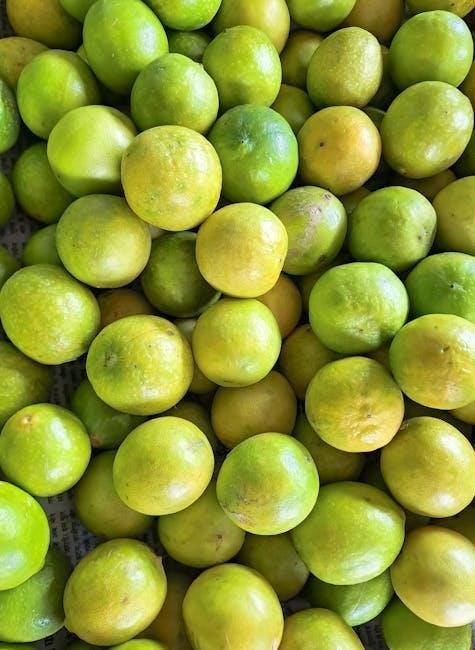The BRAT diet is a bland-food diet consisting of bananas, rice, applesauce, and toast, recommended for relieving gastrointestinal symptoms like diarrhea and upset stomachs.
What is the BRAT Diet?
The BRAT diet is a bland-food diet consisting of bananas, rice, applesauce, and toast. It is specifically designed to be low in fiber and easy to digest, making it ideal for individuals experiencing gastrointestinal symptoms like diarrhea, nausea, or vomiting. The acronym BRAT stands for its core components: Bananas, Rice, Applesauce, and Toast. These foods are gentle on the stomach and help reduce irritation during recovery from illnesses such as stomach flu or food poisoning. The diet is often recommended for both adults and children to alleviate discomfort and support digestive health during short-term recovery periods.
Purpose of the BRAT Diet
The BRAT diet is primarily designed to help alleviate gastrointestinal symptoms such as diarrhea, nausea, and vomiting. Its purpose is to provide easily digestible foods that minimize stomach irritation and support recovery. By focusing on bland, low-fiber foods, the diet reduces the digestive system’s workload, allowing it to heal. It is often recommended during acute gastrointestinal illnesses, such as stomach flu or food poisoning, to help manage symptoms and prevent dehydration. The BRAT diet is particularly useful for short-term recovery, offering a gentle and effective way to reintroduce foods after a period of fasting or severe digestive discomfort.
Components of the BRAT Diet
The BRAT diet includes four core foods: bananas, rice, applesauce, and toast. These bland, low-fiber items are gentle on the stomach, aiding digestion and recovery.
Bananas
Bananas are a cornerstone of the BRAT diet due to their easy digestibility and mild flavor. Rich in potassium and vitamins, they help restore essential nutrients lost during gastrointestinal distress. Their soft texture makes them gentle on the stomach, reducing irritation; Bananas are also low in fiber, which minimizes the risk of worsening digestive symptoms. They are particularly beneficial for replenishing electrolytes, crucial for maintaining hydration and balancing fluids in the body. This makes bananas an ideal choice for individuals recovering from diarrhea, vomiting, or stomach flu, suitable for both adults and children.
Rice
Rice is a key component of the BRAT diet, valued for its bland, non-irritating properties and easy digestibility. It is low in fiber, making it gentle on the stomach, and helps firm up stools, reducing diarrhea. White rice, in particular, is recommended over brown rice due to its lower fiber content. Rice also provides carbohydrates, which are essential for energy replenishment during recovery from gastrointestinal issues. Its mild flavor and soft texture make it a comforting option for individuals experiencing nausea or upset stomachs, suitable for both adults and children recovering from illnesses like the stomach flu.

Applesauce
Applesauce is a key component of the BRAT diet, offering a bland, easily digestible option for individuals with gastrointestinal discomfort. It is low in fiber, reducing the risk of irritating the stomach, and provides essential nutrients like vitamins and minerals. Applesauce is particularly beneficial for soothing symptoms of diarrhea, nausea, and upset stomachs. Its soft texture makes it easy to consume, even when appetite is low. Additionally, applesauce is a versatile option that can be served at room temperature or slightly warmed, making it a comforting choice during recovery from illnesses such as the stomach flu or viral infections.
Toast
Toast is a fundamental element of the BRAT diet, known for its mild, easily digestible nature. It helps stabilize the stomach and reduce nausea, making it ideal during gastrointestinal distress. Opt for plain, lightly toasted bread without added fats or seasonings to avoid irritation. Toast provides carbohydrates for energy without straining the digestive system. It is often recommended alongside bananas and applesauce to gradually reintroduce solid foods after a period of illness. Toast’s blandness makes it a safe choice for sensitive stomachs, aiding in the recovery process by minimizing discomfort and promoting a gentle return to eating solid meals.

Benefits of the BRAT Diet
The BRAT diet is beneficial for soothing digestive issues, as it is gentle on the stomach and supports recovery from diarrhea, nausea, and vomiting. Its easily digestible foods minimize discomfort and help restore energy, making it suitable for both children and adults during illness recovery.
Easy Digestibility
The BRAT diet emphasizes foods that are gentle on the stomach, making them ideal for individuals with gastrointestinal discomfort. Bananas are low in fiber and high in pectin, which helps soothe the stomach lining. Rice is a low-fiber carbohydrate that is easily digestible and minimizes irritation. Applesauce, being soft and low in fiber, reduces digestive strain, while toast, especially when dry, can help firm stools and ease diarrhea. These foods collectively create a diet that is simple for the body to process, providing quick energy without causing further digestive upset.
Relief from Gastrointestinal Symptoms
The BRAT diet is specifically designed to alleviate gastrointestinal symptoms such as diarrhea, nausea, and vomiting. Bananas provide essential nutrients and pectin, which helps firm stools. Rice is a low-fiber, easily digestible carbohydrate that soothes the stomach. Applesauce adds fiber without irritating the digestive system, while toast helps absorb excess acid and reduce nausea. Together, these foods create a gentle, non-irritating diet that allows the digestive system to recover. This makes the BRAT diet an effective short-term solution for individuals recovering from stomach flu, diarrhea, or other gastrointestinal discomforts. Its simplicity and bland nature help restore digestive balance without causing further distress.
Suitable for All Ages
The BRAT diet is a versatile and safe option for individuals of all ages, including children, adults, and the elderly. Its bland, easily digestible foods make it ideal for children with sensitive stomachs or diarrhea. Adults experiencing nausea or vomiting also benefit from its gentle, non-irritating nature. Even babies can tolerate bananas and applesauce as introductory foods. The simplicity of the diet ensures it is accessible to everyone, regardless of age or cooking ability. This makes it a practical short-term solution for anyone recovering from gastrointestinal discomfort, ensuring nutritional intake while allowing the digestive system to heal and recover naturally.
When to Use the BRAT Diet
The BRAT diet is ideal for adults, children, and during recovery from stomach flu, helping alleviate diarrhea, nausea, and upset stomachs by providing easy-to-digest nutrients.
For Adults
The BRAT diet is often recommended for adults experiencing gastrointestinal distress, such as diarrhea, nausea, or vomiting. It provides a gentle, easily digestible option to help calm the stomach.
Adults can benefit from this diet during recovery from stomach flu or other short-term illnesses. It is not intended for long-term use but can be a helpful transitional diet to ease symptoms and support recovery.
For Children
The BRAT diet is commonly recommended for children experiencing gastrointestinal issues, such as diarrhea or vomiting. It is gentle on young stomachs and helps ease symptoms without causing further irritation.
Parents should offer small, frequent portions of bananas, rice, applesauce, and toast until symptoms improve. This diet is particularly useful for children who are eating solid foods but need a temporary, bland option to aid recovery. It is not intended for long-term use but can be an effective short-term solution to soothe digestive discomfort in children. Always consult a healthcare provider if symptoms persist or worsen.
During Recovery from Stomach Flu
The BRAT diet is often recommended during recovery from the stomach flu to help alleviate gastrointestinal symptoms such as diarrhea, nausea, and vomiting. Its bland, low-fiber foods—bananas, rice, applesauce, and toast—are gentle on the stomach and easier to digest. This diet helps restore lost nutrients and provides energy without causing further irritation. It is typically suggested for a short period until symptoms subside. However, it is important to consult a healthcare provider before starting or continuing this diet, especially if symptoms persist or worsen. The BRAT diet is a safe and effective short-term solution for recovery.
Alternatives to the BRAT Diet
Alternatives include other bland foods like crackers, plain potatoes, and lean proteins, as well as nutrient-rich options such as steamed vegetables and whole grains for balanced nutrition.

Other Bland Foods
Beyond the BRAT diet, other bland foods can help soothe gastrointestinal discomfort. Plain crackers, boiled white potatoes, and lean proteins like chicken or turkey are gentle on the stomach. Steamed or cooked vegetables, such as carrots or green beans, are also easy to digest. Saltine crackers, toast, and plain rice are additional options that align with the BRAT diet’s principles. These foods are low in fiber and spices, reducing irritation and inflammation. They provide essential nutrients while minimizing digestive strain, making them suitable for individuals recovering from stomach issues or those with sensitive digestive systems.
Nutrient-Rich Alternatives
While the BRAT diet is effective for temporary relief, incorporating nutrient-rich alternatives can enhance recovery. Lean proteins like chicken or turkey provide essential amino acids without irritating the stomach. Sweet potatoes offer vitamins and minerals, while avocados add healthy fats for digestion. Low-fiber fruits like berries or bananas can replenish vitamins. Whole grains like oatmeal or quinoa introduce fiber gradually. Steamed vegetables, such as carrots or zucchini, provide vitamins and minerals. These alternatives supply necessary nutrients, supporting overall health while maintaining gentle digestion. They are ideal for transitioning beyond the BRAT diet, promoting long-term recovery and well-being.

Side Effects and Considerations
Short-Term Safety
The BRAT diet is generally safe for short-term use, providing quick relief from gastrointestinal symptoms without significant side effects for most individuals.
Risks of Prolonged Use
Prolonged use may lead to nutrient deficiencies due to its limited nutritional profile, making it unsuitable for long-term recovery or as a primary diet.
The BRAT diet is generally considered safe for short-term use, providing quick relief from gastrointestinal symptoms like diarrhea and nausea. Its low-fiber, bland foods are gentle on the stomach, reducing irritation. Suitable for both adults and children, it is often recommended during recovery from acute illnesses such as stomach flu. While it may not provide all essential nutrients, its short-term use typically does not lead to significant side effects. However, it is not advised to follow this diet for more than a few days due to its limited nutritional profile. Always consult a healthcare provider for prolonged digestive issues.
The BRAT diet, while safe for short-term use, may pose risks if followed for extended periods. Its limited nutritional profile lacks essential vitamins, minerals, and fiber, potentially leading to deficiencies. Prolonged use can hinder proper recovery and may weaken the immune system, especially in children. Over-reliance on this diet can also delay the reintroduction of more nutritious foods, slowing the return to normal digestion. Additionally, it may not provide enough calories or protein for optimal health, making it unsuitable as a long-term solution for gastrointestinal issues. Always transition back to a balanced diet as soon as symptoms improve.

Meal Plan and Recipes
A simple BRAT diet meal plan includes bananas, rice, applesauce, and toast. Breakfast: banana and toast. Lunch: rice and applesauce. Dinner: repeat or add gentle snacks.
Sample Meal Ideas
Start your day with a banana and a slice of toast for breakfast. For lunch, try plain rice paired with applesauce. Snack on another banana or a small portion of toast. Dinner can repeat these options or add gentle variations like mashed bananas or a bland rice porridge. Ensure all foods are unseasoned and free of added sugars or spices to maintain digestibility. Stay hydrated with water or clear fluids like apple juice or herbal tea. These meals are designed to be gentle on the stomach while providing essential nutrients for recovery.
Easy Recipes
Prepare simple, digestible meals using BRAT diet ingredients. For breakfast, mash a ripe banana and spread it on plain toast. Lunch can be a bowl of plain white rice mixed with a small serving of applesauce. For a snack, enjoy a sliced banana or a single piece of dry toast. Dinners can mirror these options, ensuring all foods remain unseasoned and gentle on the stomach. These recipes are easy to prepare and focus on minimizing gastrointestinal discomfort while providing essential nutrients for recovery.

Transitioning Back to Normal Diet
After symptoms subside, gradually introduce bland, low-fiber foods like lean meats, steamed vegetables, and whole grains. Monitor digestion and ensure a smooth recovery before fully resuming normal eating habits.
When transitioning from the BRAT diet, start with bland, low-fiber foods like lean meats, steamed vegetables, and small portions of whole grains. Introduce one new food at a time to monitor digestion. Avoid spicy, fatty, or high-fiber foods initially. Gradually incorporate a variety of nutrient-rich foods to ensure a balanced diet. If symptoms like nausea or diarrhea return, pause and consult a healthcare provider. This approach helps prevent overwhelming the digestive system while promoting a smooth recovery and return to normal eating habits.
Monitoring Digestive Health
Monitoring digestive health while on the BRAT diet involves observing improvements in symptoms like diarrhea, nausea, or stomach pain. Track stool consistency, frequency, and the presence of blood or mucus. Note changes in energy levels and hydration status. If symptoms persist beyond 48-72 hours, consult a healthcare provider. Watch for signs of dehydration, such as dry mouth or dizziness. Gradually reintroduce foods and assess tolerance. Keep a journal to record progress and identify triggers. This careful monitoring ensures a safe transition back to a normal diet and helps prevent prolonged gastrointestinal issues.

Who Should Avoid the BRAT Diet
Individuals with diabetes, severe food allergies, or those requiring balanced nutrition should avoid the BRAT diet, as it may not meet long-term nutritional needs for certain conditions.

Individuals with Specific Conditions
People with diabetes, severe food allergies, or malnutrition should avoid the BRAT diet due to its limited nutritional profile. Those with conditions requiring high-fiber diets or specific nutrients may find it insufficient. Additionally, individuals with chronic gastrointestinal issues, like inflammatory bowel disease, should consult their healthcare provider before starting the BRAT diet, as it may not address their underlying condition effectively. The diet’s low-fiber and low-protein content can hinder recovery for certain medical conditions, making it essential to tailor dietary advice based on individual health needs and medical history.
Nutritional Considerations
The BRAT diet is low in essential nutrients like fiber, protein, and vitamins, making it unsuitable for long-term use. It may lead to deficiencies if relied upon exclusively. Individuals, especially children, require balanced nutrition for growth and recovery. Prolonged use without medical supervision can hinder overall health. The diet lacks diversity, which is crucial for maintaining immune function and energy levels. While it aids in short-term recovery, gradual reintroduction of nutrient-rich foods is necessary to ensure proper bodily functions and prevent malnutrition. Consulting a healthcare provider is essential to avoid potential nutritional gaps and ensure a safe transition back to a balanced diet.

Comparison with Other Diets
The BRAT diet differs from other diets in its focus on bland, easily digestible foods for gastrointestinal relief, unlike diets like Paleo or Keto, which emphasize nutrient density and weight loss.
Bland Diet vs. BRAT Diet
While both diets focus on gentle, easily digestible foods, the Bland Diet is broader, often including boiled potatoes, crackers, and other low-fiber options. The BRAT Diet, however, is more specific, limiting foods to bananas, rice, applesauce, and toast. Both aim to soothe gastrointestinal discomfort but differ in flexibility. The Bland Diet offers more variety, whereas the BRAT Diet is stricter, making it easier to follow for those with severe symptoms. Both are recommended for short-term use to address issues like diarrhea or nausea, but the BRAT Diet is particularly popular for its simplicity and effectiveness in pediatric care.
BRAT Diet vs. Paleo Diet
The BRAT Diet and Paleo Diet differ significantly in purpose and composition. The BRAT Diet focuses on bland, low-fiber foods like bananas, rice, applesauce, and toast to alleviate gastrointestinal distress, while the Paleo Diet emphasizes whole, unprocessed foods such as meats, fish, fruits, vegetables, nuts, and seeds, avoiding grains and dairy. The BRAT Diet is short-term and nutrient-poor, designed for recovery from diarrhea or nausea, whereas the Paleo Diet is a long-term approach aimed at overall health and wellness. While the BRAT Diet is restrictive, the Paleo Diet offers more variety and nutritional balance, making it unsuitable for acute digestive issues.
BRAT Diet vs. Keto Diet
The BRAT Diet and Keto Diet serve distinct purposes. The BRAT Diet focuses on bland, easily digestible foods like bananas, rice, applesauce, and toast to soothe gastrointestinal issues. In contrast, the Keto Diet is a high-fat, low-carbohydrate diet aimed at weight loss and metabolic health. While the BRAT Diet is short-term and nutrient-poor, the Keto Diet is long-term and emphasizes nutrient-rich foods. The BRAT Diet lacks fats and proteins, whereas the Keto Diet prioritizes fat intake. These diets cater to different health needs, with the BRAT Diet for recovery and the Keto Diet for sustained weight management and metabolic benefits.
The BRAT diet is a bland, easily digestible diet for gastrointestinal recovery, offering short-term relief from symptoms like diarrhea and upset stomachs, commonly recommended during illness.
The BRAT diet, consisting of bananas, rice, applesauce, and toast, is a bland, easily digestible diet designed to alleviate gastrointestinal symptoms like diarrhea and nausea. It is commonly recommended for short-term use during recovery from illnesses such as gastroenteritis. The diet is suitable for both adults and children, offering quick relief by minimizing stomach irritation. However, it should not be followed for extended periods due to its limited nutritional value. The BRAT diet is a practical, temporary solution for managing digestive discomfort, helping individuals transition back to a normal diet gradually.
Final Thoughts on the BRAT Diet
The BRAT diet remains a practical, short-term solution for managing gastrointestinal discomfort, offering quick relief from symptoms like diarrhea and nausea. While it is effective for initial recovery, it lacks essential nutrients for prolonged use. It is best suited for temporary relief and should be transitioned out gradually to reintroduce a balanced diet. Consulting a healthcare professional is advised for persistent symptoms or specific dietary needs. The BRAT diet is a helpful tool for recovery but should not replace a diverse, nutrient-rich diet in the long term.
